Those who have been reading Jey Sushil in last few years, knows that Jaduguda is close to him and he is bothered about the problem of radioactive waste in Jaduguda. He did a radio documentary and series of reports for BBC Hindi in 2006.
He wrote a long piece in english in his diary but never published it. You can read it now.
To read the reports in Hindi. One can scroll down to the end and click the links given. Now the report from Jaduguda by Jey Sushil.
It was dusty and hot in the arid lands of Rajasthan…why not it was summer…summer of 98. 13th may 1998 when Buddha smiled for the second time….the human god who always preached for peace smiled with a deafening sound in the deserts of Pokharan in Rajasthan….was it a smile…may be he roared on the fickle and often ironic nature of the Indian leaders who equated his smile with the bang of a bomb..an atomic bomb which can destroy all the humanity if used in numbers less than 10. He smiled five times and then after two days he smiled again just few kilometers away in the Chagai hills of Pakistan six times.
The world surely took notice of the smiles but no one noticed his continued weeping over the humanity in a place called Jaduguda in India.
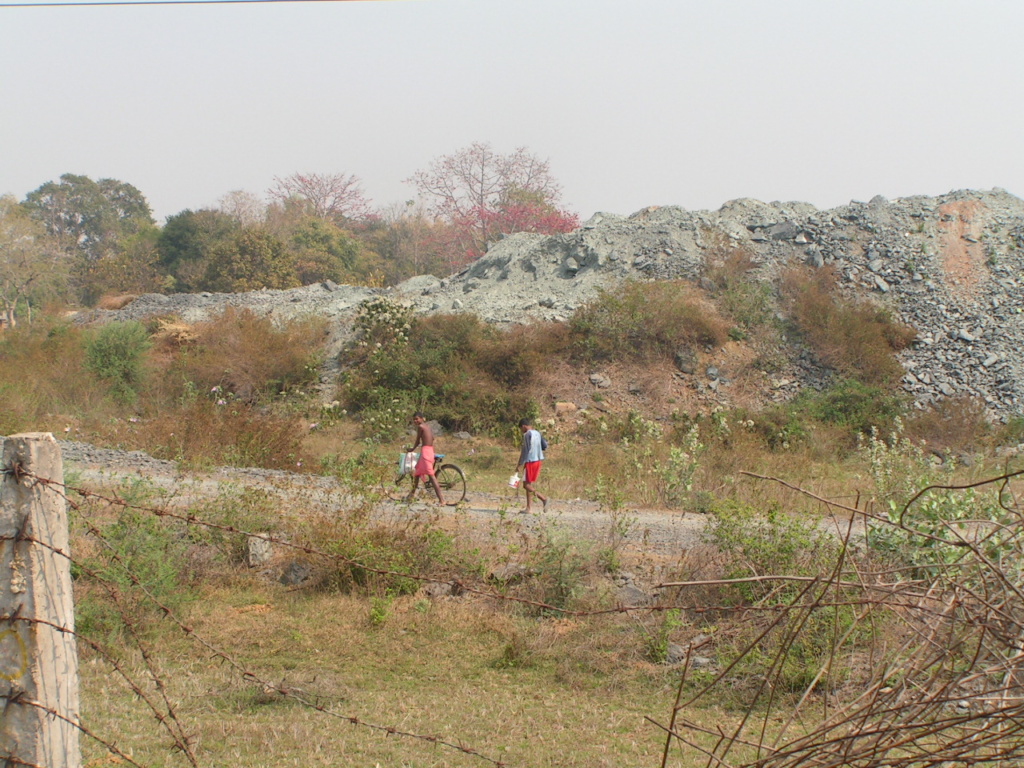
The waste in Jaduguda
Jaduguda, which is the birthplace of India’s nuclear bomb, literally means the ‘place of magic’. The only active uranium mining site in India was established in the early nineteen sixties. Unfortunately, it is my birthplace as well. I was born here in 1976, two years after India’s first nuclear explosion.
There were no celebrations in Jaduguda when India tested its first bomb in 1974 because Uranium miners of Jaduguda were on a minor strike for the increase in their pay. Miners never came to know that they had any role in making India a nuclear power.
Though after almost three decades now people in Jaduguda somehow understand how this double edged sword called uranium cuts both ways.
I realised it after 1998 when some newspapers published reports about the ill effects of radiation in Jaduguda and nearby areas.
Gradually I tried to figure out the relation between the mines, tailing ponds (the open place where the radioactive waste gets dumped ) miners, local population and diseases.
When I joined BBC World Service Radio, a colleague quipped, ‘you are from Jaduguda. You will definitely do well in radio because you are already radio- active!’.
It was funny but a terrifying truth with which everyone in Jaduguda lives. Few years back (2006) when I went there again to make a documentary, I came face to face with this truth again.
***
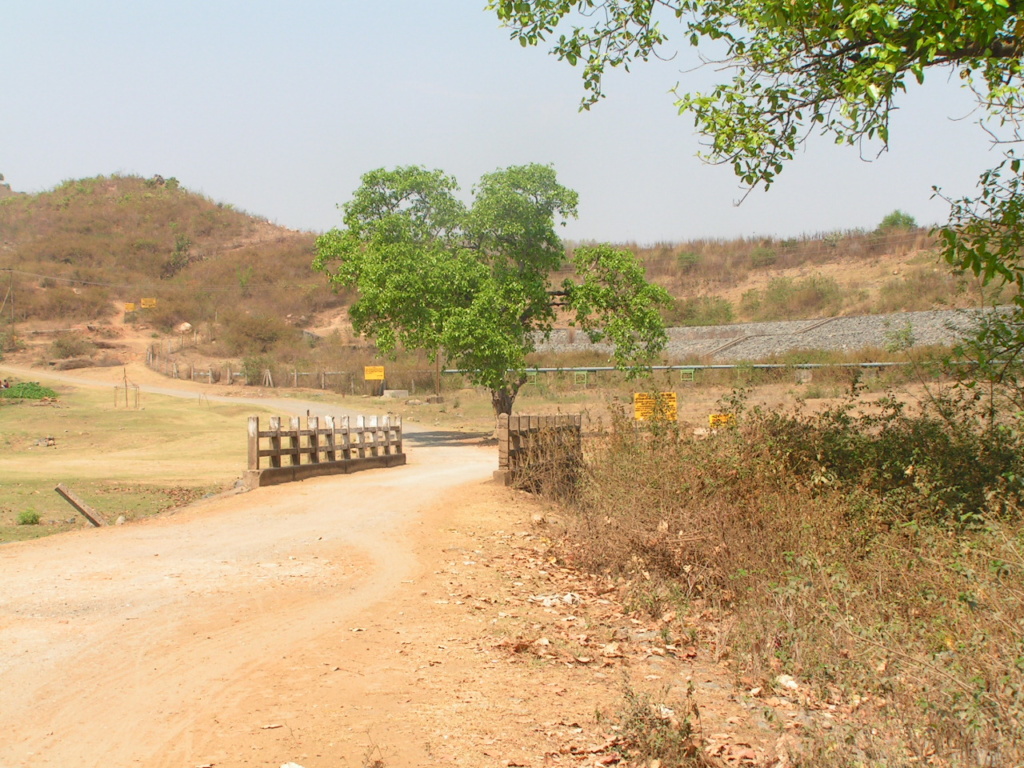
The Entrance to the Tailing ponds where unauthorised entry is banned.
It was a bright Tuesday morning when we reached the spot. For me it was my birthplace where I lived for 24 years. Here I was, for the first time merely/ just as a journalist.
I had fixed most of the interviews we had to do and I was supposed to know the story in and out. My British presenter Mark Whitaker was still a bit skeptical just as any veteran journalist would be, who had at times heard so much about any story but found things quite normal on the spot. But this time it was not going to be the same for him.
Not even for me.
The house of Mr. Ghanshyam Biruli was quite impressive compared to other houses in the vicinity. Standing from here one can watch the mountains and jungles behind which lay the sea of dust, which was apparently causing huge damage to the lives of the people in that area. Oh! so very normal?
No, it was not.The dust was not just any industrial waste, in-fact it was radioactive waste. ‘Noooo……’ said my presenter…. ‘it can’t be so close to population.’ I was quite confident because I have been to that dust field umpteen times in my childhood. ‘Come on Mark I played cricket there years ago’, I said.
‘Pharr…ok let’s start then.’
We interviewed Mr. Ghanshyam Biruli who spoke like a professional. He has been doing that for the last six-seven years. He was projecting himself as the lone ranger in the area fighting against the radioactive pollution. He was alone because there were still not more than ten people who were really aware that radioactive waste can cause serious damage to one’s health.
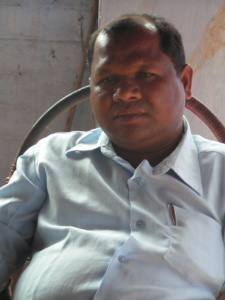
Ghanshyam biruli who runs Jharkhand Organisation against Radiation in Jaduguda
Even I was unaware about the dangers when I lived in Jaduguda. I realised the gravity of the problem during my early years as a journalist. I knew Mr Biruli as someone whom everyone in the vicinity should avoid, because he wanted the mines to be closed. No one wanted the mines to be closed/shut as it provides the only government job in the area.
Now I know he is an activist. He laughed, when I told him about his impression on me. ‘I have been called a traitor and what not’, he replied.
His father was a miner who died of cancer. After 1998 (The year of the second nuclear tests) with growing awareness of its ill-effects, he took up the issue of the radioactive waste.
The waste is there because of the material generated from the mining dumped in the designated areas called ‘tailing ponds’ which are not very far from the population. More than five villages or say five thousand people live less than two kilometers from the tailing ponds. Some villages like Chhatikocha and Tilaitandi are hardly a few hundred meters away from the tailing ponds.
According to Mr Biruli, he was threatened by the Uranium Corporation of India Limited (UCIL), the company which looks after the mines. After the interview Mr. Biruli called up a person named Chhatua Das. Das, an auto rickshaw driver, wanted us to meet his daughter who can’t speak or walk or do anything.
When Chhatua Das told us about his seven year old daughter whom they had fondly named Gudia (which means doll), we could not understand what kind of ailment he was talking about.
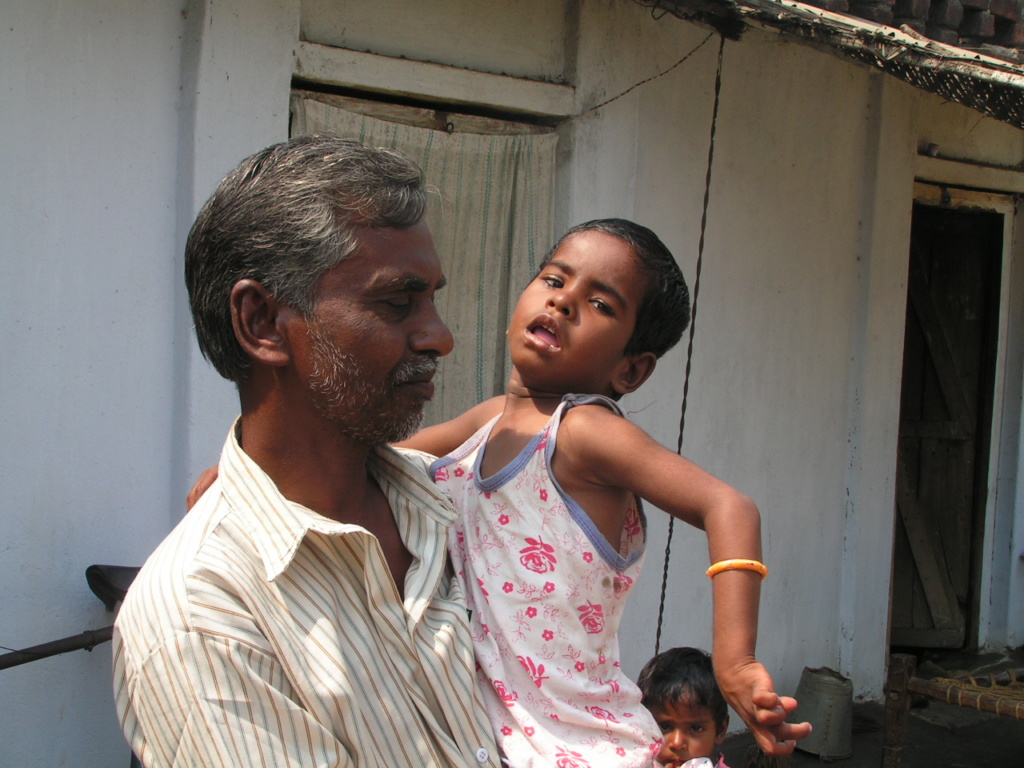
Chatua Das with his daughter Gudia
We reached his small hut in ten minutes and there on a charpoy lay Gudia. She was seven years old, her legs and hands stiff like wood. She couldn’t speak, move on her own or give any clue to what she is suffering from? We tried to chat with her….but failed…she stared at her father and made sounds like a caged bird…aaaaaaan….aaaaaan…aaaaann.
Her father understood her code language. He caressed her, and she became happy. She looked to my presenter in the eyes …he was white and bald. Gudia had never seen a white man before, the expression on her face changed, we thought she will cry. But her father told us, ‘she is happy and smiling.’

Nobody knows what Gudia is ailing with
Mark was lost for words, so was I. Her father was worried about her future because there was no doctor who can give any kind of treatment or even assurance about Gudia.
We moved to another house nearby. …the owner came to us and requested us to meet his brother and sister. He asked us not to reveal his identity as he was afraid of losing his job in the company i.e UCIL.
His brother Dunia (which means world) was 20 years old and a sister who was 21 named Aalowati (which means one who gives light) were eating when we reached their home.
Both of them were severely paralysed. They were eating like three or four year old babies.
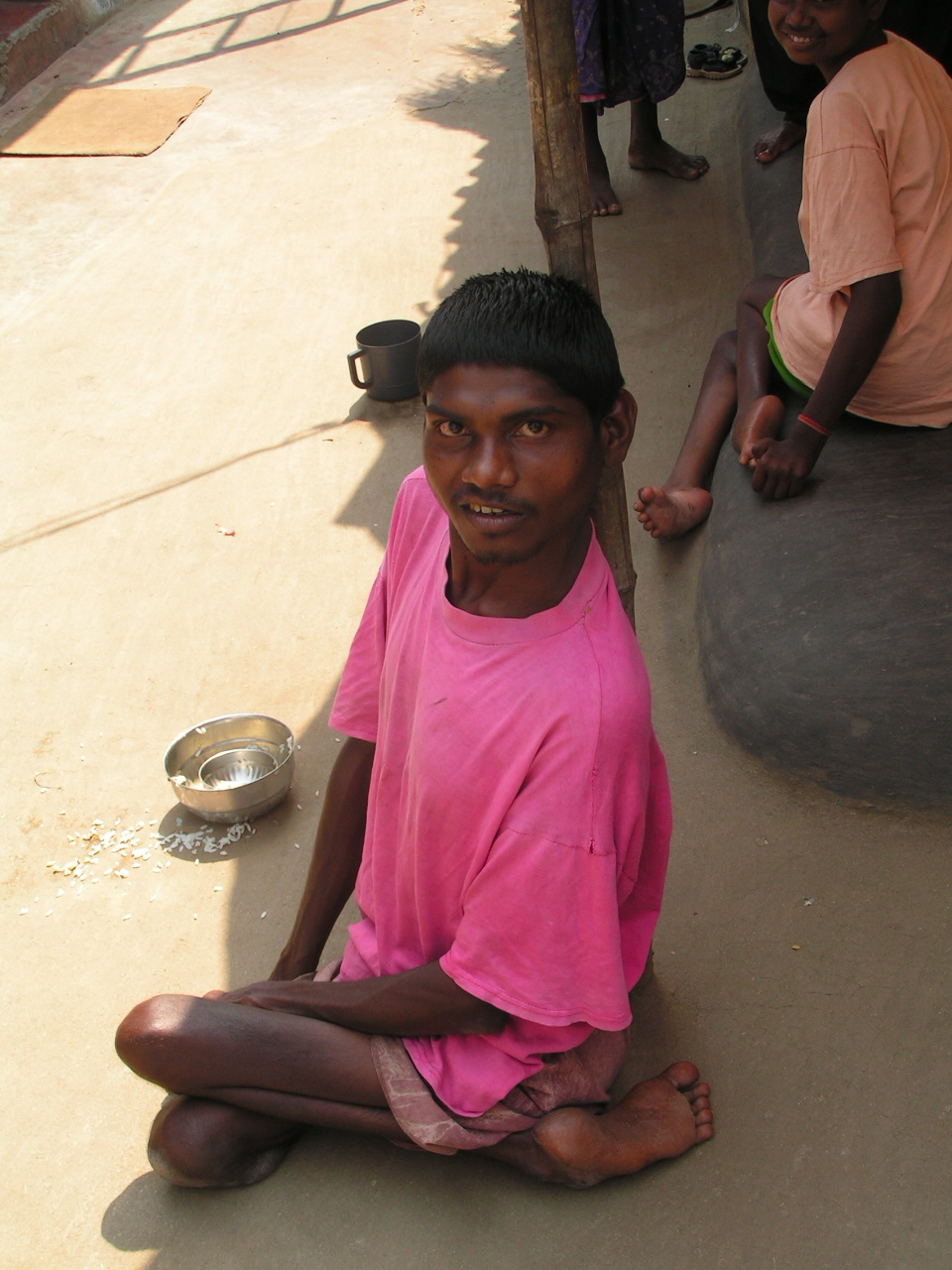
another mysterious ailment of Dunia
Their bodies below waist were unmovable. The legs looked polio stricken but we were told that they were like this by birth and they couldn’t speak. They had no language like us…their hands were stiff and fingers inflexible.
Dunia looked at us and we thought he would talk. He tried hard but no one understood what he said. His unspoken words still haunt me. They were something like aaaennn ……dhhhhhhh…eeeeeee.
I took some pictures and the flash light of the camera made Dunia happy. He smiled but not like Buddha. I asked his brother about Dunia’s ailment. He had no idea, local doctors gave no specific reasons for the ailments. He said his brother and sister were born with these deformities.
I could imagine that when Gudia will be in her twenties, she would be like Aalovati or Dunia. I told this to Gudia’s father Chhatua Das and he replied, ‘Do you think she will live that long?’

Sister of Dunia is named alowati
I had no answer. Chhatua’s wife has had four stillborn babies. They had no hope. His wife didn’t want to talk about her pregnancy problems.
It was time to leave Dunia’s world. Someone told us to meet Moti, a cycle mechanic. We drove down to his shop.
When I saw Moti I remembered, I had got my cycle repaired by him so many times. I asked him, how he was and he replied….kaise honge….waise hi hain..Aap kaun hai… (How can I be? ok.. Who are you?).
By then people surrounded us. I knew some of them. Some of them knew me too. Moti was 22 years old and his legs looked like a melted piece of metal. He explained to my utter astonishment ‘…andar se tuta hai bahut baar. kharab lagta hai.lekin kya kar sakte hain’ (It is broken from inside so many times, it looks awful. Doesn’t it but what can I do). His father Paanchu Ram had no clue about the ailment or the causes of it.
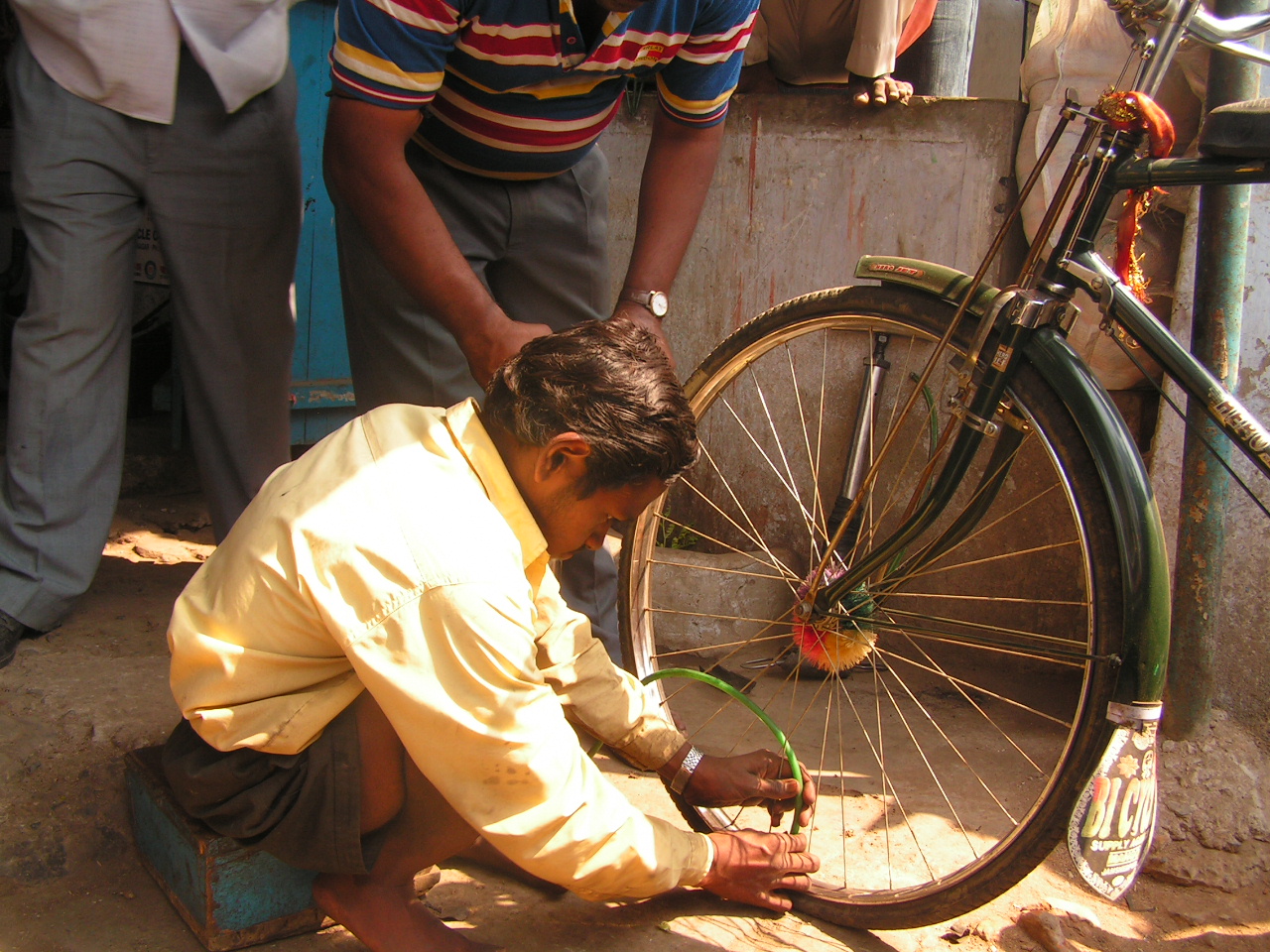
Moti repairs cycles in Jaduguda
He said, ‘I can’t tell you. I don’t know why this happened. Doctors don’t tell us anything about it.’
‘Do you think the mines and radiation is responsible for this’, I asked.
He stared at me and then said, ‘I am not a doctor, what I know is that it started when we came here. Earlier Moti was fine. His legs started breaking on their own when he was six and now look what has happened to him. Government gives no help. He is earning his living from this cycle shop. He is handicapped. He should get some help.’
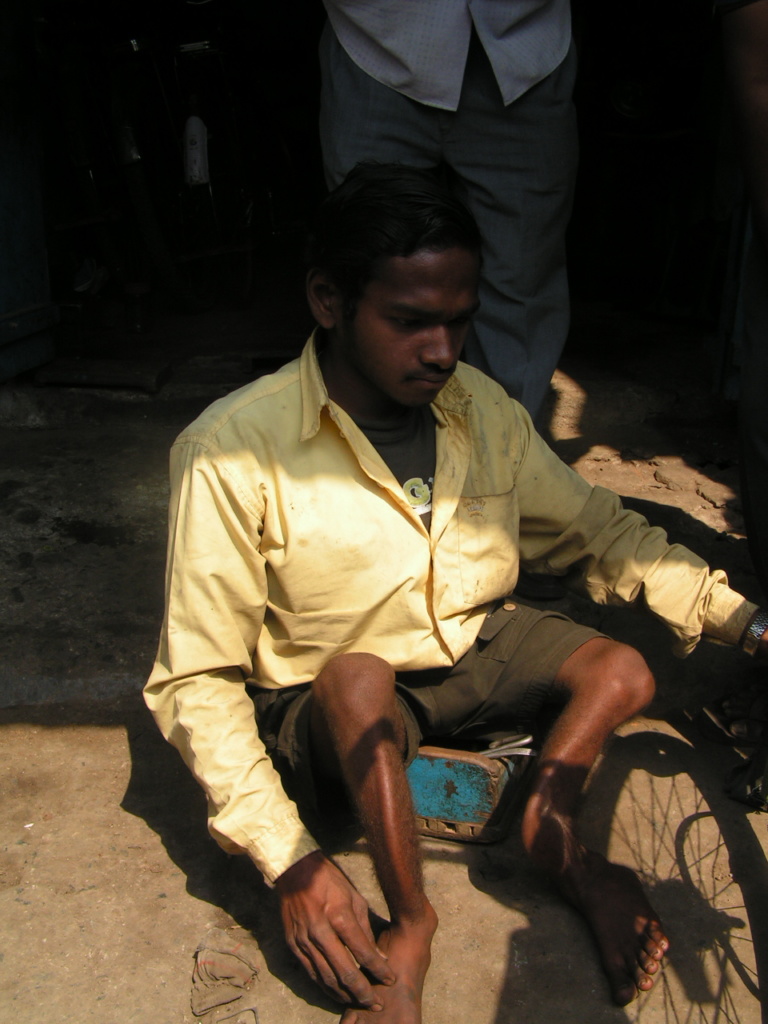
Moti’s legs are severely broken from inside without any incident
By then the number of people soared near the shop which was a stone’s throw away from the uranium Mines. I asked people what they thought about Moti and his ailment. There was a sudden silence .Then someone said, ‘come here I will tell you.’
Why you? Why not these people? I asked, ‘They work for the company but I don’t’, he replied.
His name was Lallan Prasad and he owns a shop near Moti’s cycle repair shop. Lallan knew my family well.
He explained to me ‘look Sushil, you don’t live here anymore; you don’t understand. No one will speak against the company. It is all because of the company which does the mining of Uranium. Uranium is a deadly substance. The waste generated by it is dumped nearby. It pollutes water and everything else. ’
How can you be so sure? I wanted to ask but kept quite.
He looked me in my eyes and said, ‘Okay, look for older people in Jaduguda. Tell me how many of them manage to live beyond sixty-five?’
They were really very few old men there. In the last two days that we were there, we saw one or two old men but I kept quite.
He asked me again, ‘do you remember how many people suffer from cancer here, just think.’
Yes… Prasant a friend of my brother, Jagjivan uncle, Maina auntie , Khosla uncle, Subodh a distant friend… many more names came to my mind. I lost count.
Do you realize that people here suffer from skin problems, indigestion and stillbirth? He asked me again.
He was right to an extent. Even my mother confirmed to me that stillbirths were quite common in the area and I remember I had a terrible skin disease once and one of my cousins is humpback and his hands are awfully twisted since birth.
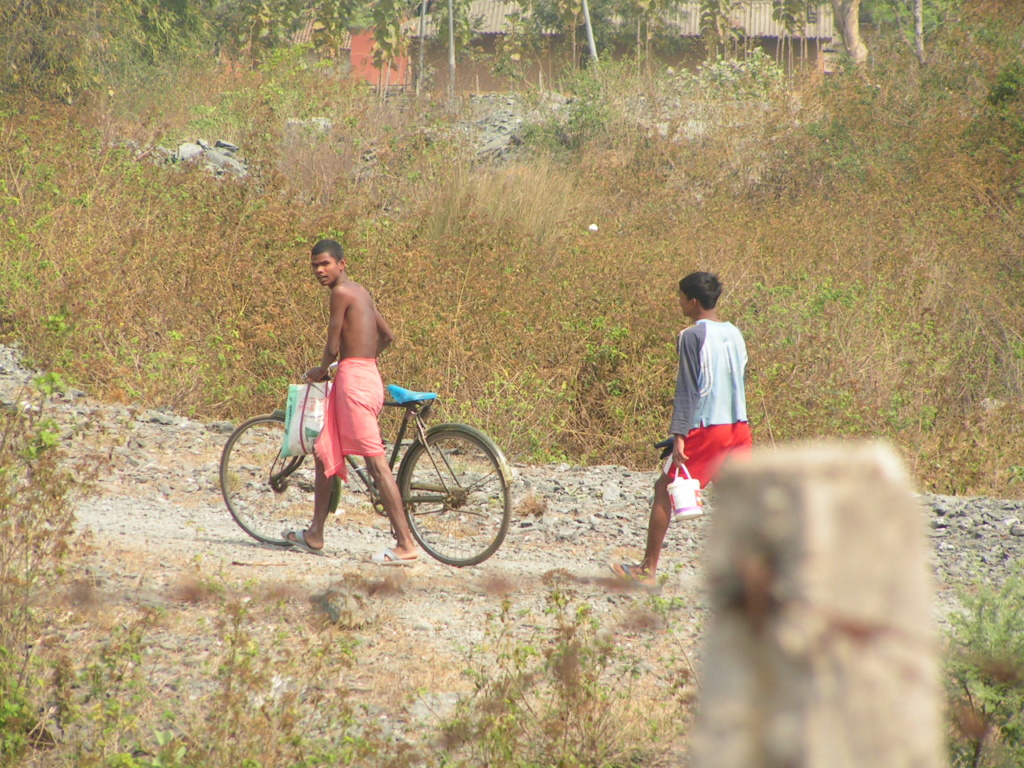
people work near tailing ponds
Once Lallan spoke, the crowd laughed and then said…ask us now…but no names… I said fine.
Lallan smiled and said ‘tumko sub mil jaayega.sub cheez ka jawab milega. (roughly translated it resonates the Bob Dylan song ‘ ‘answer my friend, is blowing in the wind’)
They were quite forthcoming in blaming the government (in this case, the company) for all their problems. Right from the medical problems to the problems of livelihood and everything else they could think off.
In India it is quite common to blame the authorities for everything. I had that experience before. So I turned the question around. Do you feel proud of India’s nuclear bombs? I asked.
The answer came sporadically, ‘yes it was made from this uranium. we made the bomb….but no one talks about us…or the place. Everyone talks about Pokhran.’
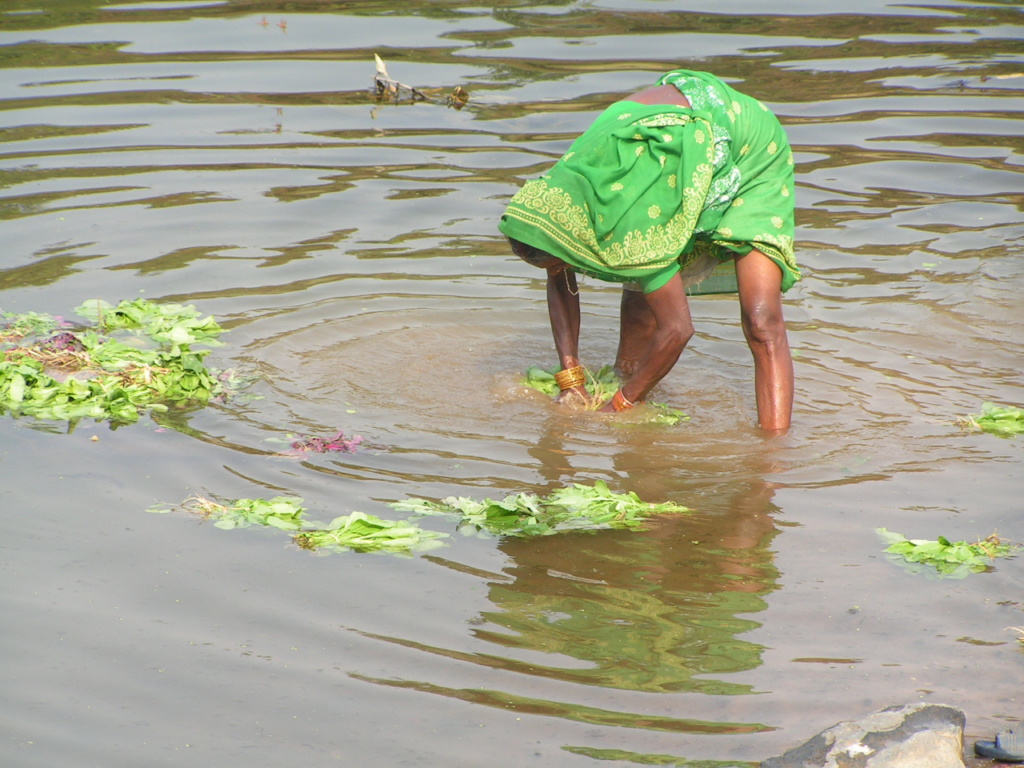
people wash vegetable in the water coming from the mines
‘Come on, Buddha smiled there’, I said. The reply came instantly – ‘But Buddha weeps here…’someone in the crowd said.
The words struck me and struck me hard. I knew I have got my headline.
I poked them further and then came forth the anguish, frustration and desperation of the people of Jaduguda.
The young lads in the crowd were excited (may be because for the first time some well known media house was talking to them) and they told me so many things, though indirectly.
So what do you think the people of Jaduguda are? I asked.
‘Martyrs, like the soldiers who died in Kargil ! (The latest skirmish between Indian and Pakistani on the Kargil mountains). We are like elements for sacrifice to achieve power.’
Who was that, I thought! Quite an elegant way to put it. I asked his name, he refused to answer but said, ‘There are so many kids dying here, no one knows about their diseases .You can smell death. Slow death. I don’t know what causes it but definitely this mine has something vicious about it. Ask the miners how they feel. Don’t come to me.’
His eyes were bulging. Later I learnt that one of his brothers is also handicapped like Gudia and Dunia. His brother died recently.
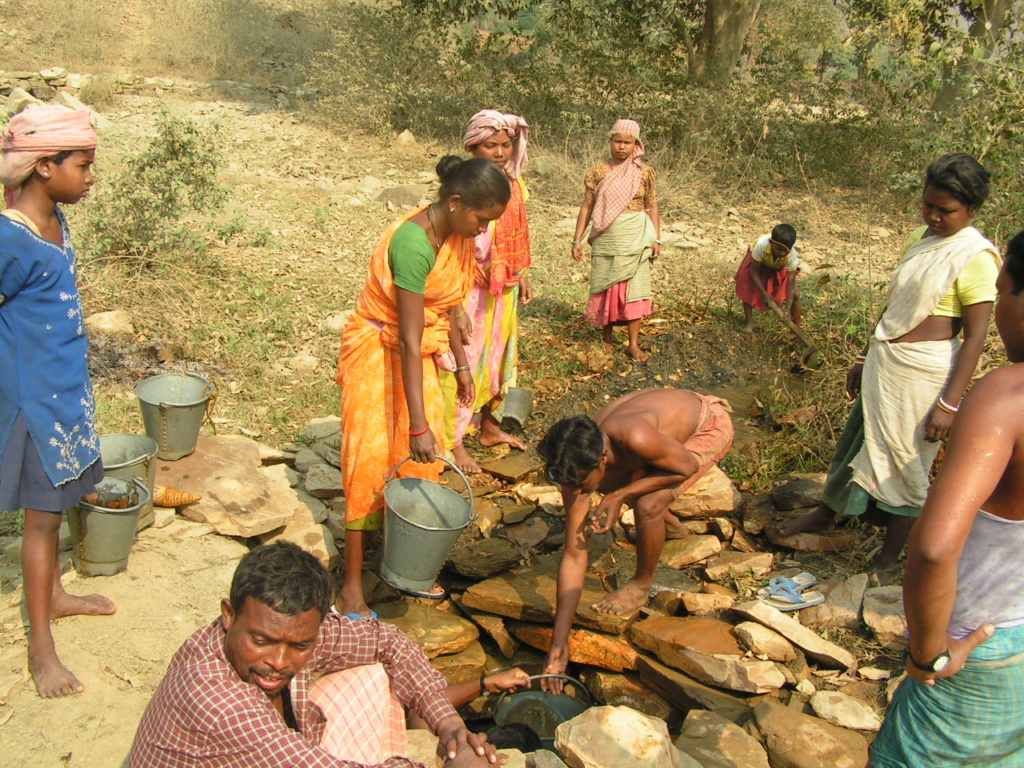
one of the village water source just 500 meters from the tailing pond
In the crowd I found one of my schoolmates as well. Sushant used to be a very good football player. Now he drives the truck which carries the nuclear waste from mines to the tailing ponds.
He looked frail and emaciated. I asked him about his health and football. He said, ‘Now I can’t play football. I get tired if I run. Once in a month I fall sick. No energy. No football.’
He earns a daily wage of 50 rupees (approx One dollar) as a contract driver. He told me that the drivers don’t get any protective gears from the radioactive waste. They are in contact with the waste for 8 to 10 hours every day.
I was shocked to know this but while talking to me; he stopped a truck carrying the waste and showed me the uncovered heap of waste in the truck.
I have seen these trucks as a kid and many times and I followed these trucks in order to overtake it with my motorcycle. These trucks pass through the population and at times the waste it carries fall down on the roads. Poor people use these rocky wastes in building their huts as well.

Trucks carrying the radioactive material with our any protection
I also remember one of my friends named Rakesh. I knew him well as we used to go to his small hotel to eat snacks and have tea in the evening…the body below his neck had no movement. A servant was always nearby to help him. Despite the problem, he was always jubilant and happy. Whenever I saw him I found him happy. Sometimes he smoked a cigarette with the help of his servant.
One day he asked me something in private, ‘Do you have any pictures of sexy girls. You know I need to see them. I can’t do anything but still eyes can be soothed…haha ha ha ha.’
I went to the hotel only to be informed that Rakesh had died six months ago. He was 21 when he died. When I tried to talk to his father Mr Khosla, he said that he tried to get the best medical care for his kid, but failed to save him.
He said to me, ‘It was good that Rakesh died before me. After our death who could have cared for him. His disease was rare but can’t say that it was because of radiation. I have no idea. Doctors never said that to me.’
There are more than 50 children in Jaduguda and nearby areas with mental and physical deformities and no one knows the reason of their ailments. Government doctors refuse to talk and other practitioners says that they are not well equipped to say that these ailments had anything to do with radiation.
The doctors accept that these ailments are unusual and such problems are confined to this area only.
So am I also affected by the radiation if at all there is any effect? I always try to evade that question even in my dreams.
Naturally the UCIL denied any such effect on anyone and always maintained that the mining was safe and within the permissible standards.
How can that be? I remember my father coming home in the same clothes in which he used to work in the mines. My eldest brother, who worked for a brief period in the company, used to smell very different when he came home.
He never took shower inside the company premises. He always said, ‘No good soap and towels are there. With cold water very few take bath there. Everyone comes home.’ According to rule it was mandatory to take bath when anyone came out of the mines.
UCIL boasts of its safety arrangements. They tried to do the same in a meeting with me. They refused to come on record although they promised to do the interview. But during our meeting later they tried to convince me about the sinister plans of the foreign media against India, in this case the BBC.
One of them said, ‘You don’t understand. Foreigners don’t want India to become nuclear power so they are scaremongering about these things.’
But India is a nuclear power already, I retorted. ‘So what, foreign powers don’t like it,’ they said. They tried to convince me that I was just a puppet in the hands of foreign media. They also wanted to know whether I work in BBC or only a fixer for them.
Later on when I came back to Delhi, I tried hard to get answers from the central authorities but never got any audience with them, despite repeated emails and phone calls.
I was left with nothing but to ponder upon my past and try to draw some insights. I met several of my schoolmates who are still there working in the mines.
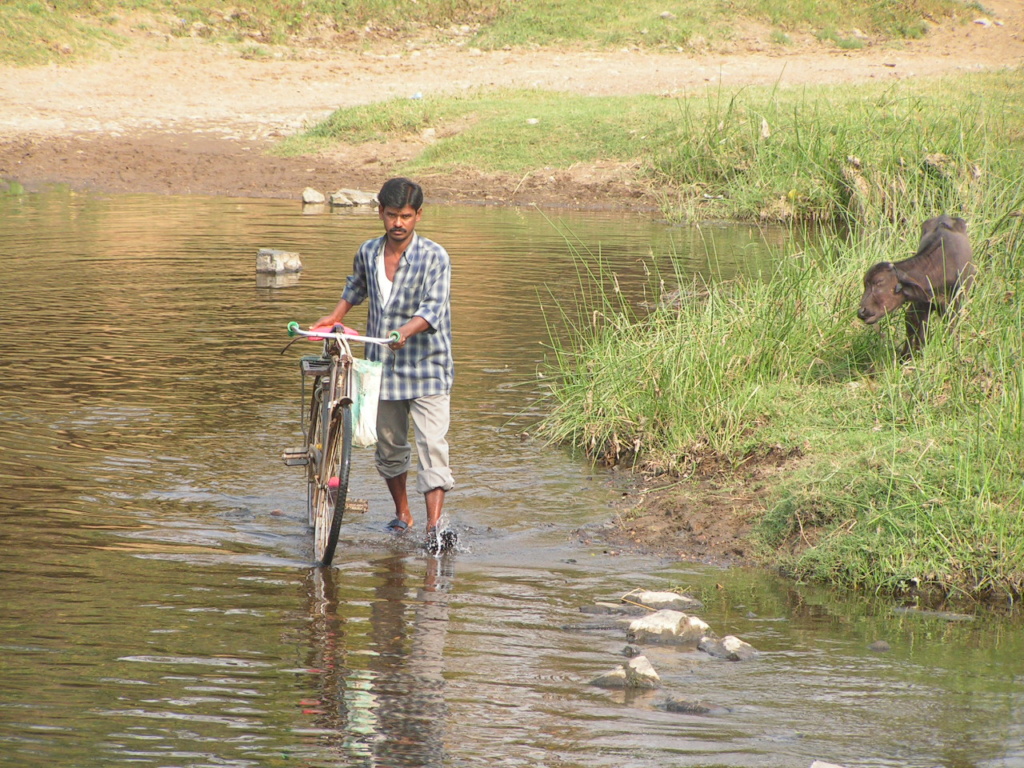
The river polluted with the waste
One of them used to work in a local newspaper. Later on he joined the company but never got promoted in the company and was once threatened as he commented about the radiation problems in one of his less important pieces in the column. Afterwards he stopped writing.
He said to me, ‘I have kids. I have to live. What I could have done. I am neither an activist nor a big journalist and here every newspaper reporter gets threatened by the company if they write against them.’
I realized the problem of livelihood. The same problem which had lured my father to this place in the 60’s when the mining started. It was the late Dr Homi Jehangir Bhabha who is known as the father of atomic energy in India who laid the foundation of UCIL. I still remember his portrait hung in our school.
Don’t know whether he envisaged the things in the same way as it exists now. ‘No he could never do that, he was a good man. He used to take care of us’ , retorted my father who never met this iconic scientist but still revers him.
My father used to tell me stories like any old man about his past. When he gets nostalgic about the old days, this is what he says, ‘When I joined it was so good. We used to get boiled eggs and milk in the company for free. Good soap and towels to bath and good care of the officers. We felt privileged then. Things changed. Miners and all workers should get those facilities even now.’
But back in the 1960’s no one wanted to work in the mines. Everyone loved their fields and easy life. Jaduguda used to be a big jungle then, where my parents lived in the tents with lions, bears and snakes as friendly neighbours.
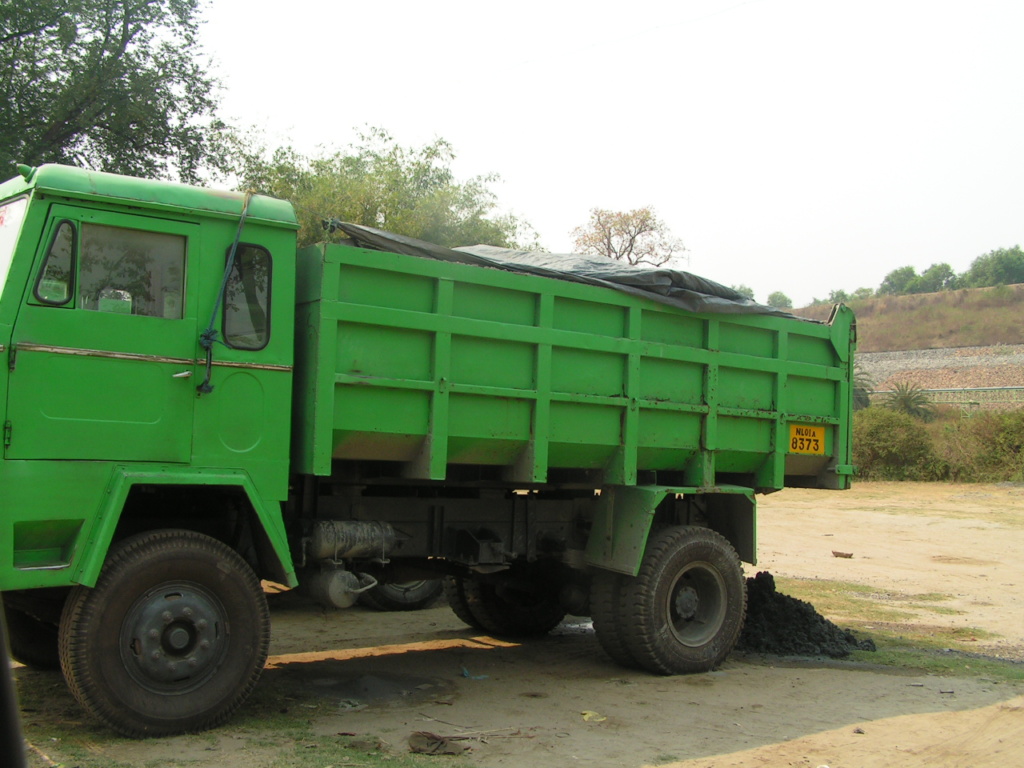
The trucks passes the population everyday
On every weekend my father and others would go to the nearby villages to bring some labourers to work in the mines. Sometimes, they were forcefully loaded in the truck and brought to the mines. They normally fled after two or three days. All of these villages were of tribal people who hated to work anywhere other than their fields.
But things changed and I remember, in early nineties, there was a big demonstration by these people for jobs in the company. What an irony! They wanted to work for the demon who had cursed their generations.
I was desperate to get concrete evidence . Greenpeace had done a report in which they mentioned that in at many places in Jaduguda, the radiation is higher than usual. I needed some more evidence. Mr Biruli put me in touch with a scientist couple who had done medical survey and research in Jaduguda. Sanghmitra Gadekar and her husband Suresh Gadekar are physicists and they publish a magazine called Anumukti (liberation from atom).
I read their report on Jaduguda and talked to them. Here is what they had to say.
‘It is very difficult to relate genetic disorders directly to the radioactive waste but when you look at the disease faced by the people living near the tailing ponds , one can realize the extent of damage done’, says Sanghmitra Gadekar.
She explained to me through the pictures, ‘Stunted growth of body parts, no toes, eyes, ears or uneven growth of body, high rate of premature birth, stillborn babies are common in the area. These are the problems one can find in Hiroshima and Nagasaki where radiation has done extensive damage….so you can say these things have something to do with the radioactive waste lying in the backyards of these villages.’
To an extent I find it convincing because in my travels in India, I never saw such diseases and when I showed the photographs and video footage of Gudia and Dunia to many of my fellow journalists and numerous other friends, no one had seen something so ghastly earlier.
Then there were two more reports; One by a Japanese scientist Hiroaki Koide, who took the readings of radiation in different places in Jaduguda.
His report says, ‘The contamination from a uranium mine has spread in Jaduguda. There are places where uranium concentration is high on the road and riverside. Near the tailing ponds the radiation levels are alarmingly high.’
The other report was by local legislators who formed the environment committee. Their report came in 2001 in which they clearly stated that radiation is an issue in Jaduguda which has to be taken care of. In an interview with me, Chairman of the committee, Gautam sagar Rana was quite forthcoming.
He said , ‘I am not a scientist but when you meet the kids and talk to the local population you realise they intensity of problem. What other than uranium mining can cause such genetic disorders? It should be investigated by the international experts’.
The environmental committee in their report recommended that there should not be any human population living within the five kilometre radius of the tailing ponds and the villages should be relocated. No one listened. The villages and villagers are still there.
The UCIL came up with its report saying there was nothing unusual and there was no problem caused by the radioactive waste. It was a report prepared by Bhaba Atomic Research Center (BARC) on behalf of UCIL.
Then what is the reason for such diseases?The BARC report and the company officials say that the local population specially the tribals drink a lot of alcohol and local liquors which makes them vulnerable to diseases for which tailing ponds can’t be held responsible..
I was amazed with their analysis as I can see very clearly the connection. Poverty, hunger and ignorance make anyone vulnerable to a monster like radioactive waste which causes long term damage. I knew UCIL will never agree with me.
And after what I saw I can never agree with the UCIL.
POST SCRIPT: The photos were taken in 2006 and I was told that after the report the trucks were covered with clothes. About Gudia, Dunia and Alowati, I was told after posting this article that Gudia is no more. . Moti was alive in 2015 when I met him last time. I didn’t have the courage to ask abt others as they had constantly asked me after the reports that whether they will get any compensation to which I had no answer.
Links to read the different stories in Hindi.
http://www.bbc.com/hindi/regionalnews/story/2006/05/060513_jaduguda_story.shtml
http://www.bbc.com/hindi/news/cluster/2006/05/060525_jaduguda_uranium.shtml

It is indeed a wonderful piece of diary which tells the reality of the diarist’s perspective ;state has to gain power and the people are mrely human resources!
Thanks for reading
किताबों में पढ़े जादूगोड़ा में जीवन ऐसा करुण होगा, कभी सोचा नहीं था। व्यवस्था इतनी बेशर्म और निर्दयी हो सकती है यह भी समझ नहीं था। हैरानी इस बात की कि जबकि वहां लोगों को रेडिएशन के प्रभाव से बचाना असंभव नहीं होगा, केवल कायदे से मजबूत कदम उठाने की जरूरत होगी, अंतर्राष्ट्रीय मानकों को ईमानदारी से लागू करने भर की जरूरत होगी, तिसपर इतनी अनिच्छा और बेशर्म! बहुत-बहुत दुःखद रिपोर्ट!
Thanks for reading
रक्षा-सुरक्षा जैसे फर्जी मुद्दों की वजह से माईन्स तो बंद नहीं करेगी सरकार लेकिन यह समझ नहीं आता कि इतनी भयानक स्थिति होने के बावजूद इनका विस्थापन क्यों नहीं किया गया ? पांच-दस हजार लोगों का विस्थापन इतना भी मुश्किल नहीं था ! यहां एक हाईड्रो इलेक्ट्रिसिटी प्रोजेक्ट में इससे ज्यादा लोग विस्थापित किए जाते हैं । एक और बात यह कि लोगों को अब तक इतना कुछ खोने के बाद भी मरने से डर क्यों नहीं लग रहा ? सरकारी नौकरी का लालच अपनी जगह है लेकिन वो आने वाली नस्लों की जिंदगी से बढ़कर तो नहीं हो सकती है न !
आप जितना सिंपली समझ रहे हैं मुद्दे को उतना सिंपल नहीं है. जब सुशील जैसे पढ़े लिखे आदमी को यह समस्या समझ में तब आई जब वो दिल्ली पहुंचे तो वहां रह रहे लोगों को तो समझ में कितनी मुश्किल से आ रही होगी ये सोचिए. कॉलोनी अलग है जहां दसेक हज़ार लोग होंगे. आसपास गांव हैं जहां कि आबादी अब बीस हज़ार से अधिक होगी जिन्हें दूसरी जगह ले जाना मुश्किल नहीं है लेकिन कोई सरकार करती नहीं है क्योंकि ये कोई बांध का प्रोजेक्ट नहीं है कि तबाही डायरेक्ट दिखे. यहां दिखता कुछ नहीं है जो दिखता है उसका डायरेक्ट रिलेशन स्थापित करना मुश्किल होता है. पिछले कुछ सालों में रिसर्च हुआ है तो रिपोर्टें आई हैं. पहली रिपोर्ट ही नब्बे के दशक में आई कि प्राब्लम है. उससे पहले तो प्राब्लम का जिक्र तक नहीं होता था.
ये लाइन बहुत दमदार है- यहां के लोग वो तत्व हैं जिसकी आहुति देकर भारत परमाणु शक्ति बना है। पैसे और पावर की चाह ने इंसान को भी नहीं छोड़ा है।
Thanks